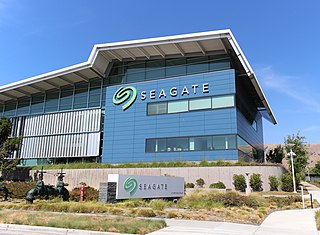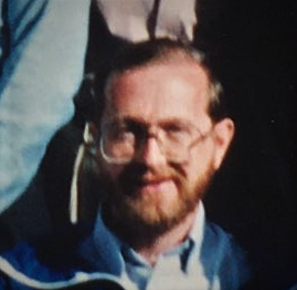
A hard disk drive (HDD), hard disk, hard drive, or fixed disk, is an electro-mechanical data storage device that stores and retrieves digital data using magnetic storage with one or more rigid rapidly rotating platters coated with magnetic material. The platters are paired with magnetic heads, usually arranged on a moving actuator arm, which read and write data to the platter surfaces. Data is accessed in a random-access manner, meaning that individual blocks of data can be stored and retrieved in any order. HDDs are a type of non-volatile storage, retaining stored data when powered off. Modern HDDs are typically in the form of a small rectangular box.

Seagate Technology Holdings plc is an American data storage company. It was incorporated in 1978 as Shugart Technology and commenced business in 1979. Since 2010, the company has been incorporated in Dublin, Ireland, with operational headquarters in Fremont, California, United States.
In computer data storage, partial-response maximum-likelihood (PRML) is a method for recovering the digital data from the weak analog read-back signal picked up by the head of a magnetic disk drive or tape drive. PRML was introduced to recover data more reliably or at a greater areal-density than earlier simpler schemes such as peak-detection. These advances are important because most of the digital data in the world is stored using magnetic storage on hard disk or tape drives.

Magnetic storage or magnetic recording is the storage of data on a magnetized medium. Magnetic storage uses different patterns of magnetisation in a magnetizable material to store data and is a form of non-volatile memory. The information is accessed using one or more read/write heads.
Density is a measure of the quantity of information bits that can be stored on a given length of track, area of the surface, or in a given volume of a computer storage medium. Generally, higher density is more desirable, for it allows more data to be stored in the same physical space. Density therefore has a direct relationship to storage capacity of a given medium. Density also generally affects the performance within a particular medium, as well as price.
Perpendicular recording, also known as conventional magnetic recording (CMR), is a technology for data recording on magnetic media, particularly hard disks. It was first proven advantageous in 1976 by Shun-ichi Iwasaki, then professor of the Tohoku University in Japan, and first commercially implemented in 2005. The first industry-standard demonstration showing unprecedented advantage of PMR over longitudinal magnetic recording (LMR) at nanoscale dimensions was made in 1998 at IBM Almaden Research Center in collaboration with researchers of Data Storage Systems Center (DSSC) – a National Science Foundation (NSF) Engineering Research Center (ERCs) at Carnegie Mellon University (CMU).
In computing, a hybrid drive is a logical or physical storage device that combines a faster storage medium such as solid-state drive (SSD) with a higher-capacity hard disk drive (HDD). The intent is adding some of the speed of SSDs to the cost-effective storage capacity of traditional HDDs. The purpose of the SSD in a hybrid drive is to act as a cache for the data stored on the HDD, improving the overall performance by keeping copies of the most frequently used data on the faster SSD drive.
Heat-assisted magnetic recording (HAMR) is a magnetic storage technology for greatly increasing the amount of data that can be stored on a magnetic device such as a hard disk drive by temporarily heating the disk material during writing, which makes it much more receptive to magnetic effects and allows writing to much smaller regions.
In 1953, IBM recognized the immediate application for what it termed a "Random Access File" having high capacity and rapid random access at a relatively low cost. After considering technologies such as wire matrices, rod arrays, drums, drum arrays, etc., the engineers at IBM's San Jose California laboratory invented the hard disk drive. The disk drive created a new level in the computer data hierarchy, then termed Random Access Storage but today known as secondary storage, less expensive and slower than main memory but faster and more expensive than tape drives.
Patterned media is a potential future hard disk drive technology to record data in magnetic islands, as opposed to current hard disk drive technology where each bit is stored in 20–30 magnetic grains within a continuous magnetic film. The islands would be patterned from a precursor magnetic film using nanolithography. It is one of the proposed technologies to succeed perpendicular recording due to the greater storage densities it would enable. BPM was introduced by Toshiba in 2010.
Noise-Predictive Maximum-Likelihood (NPML) is a class of digital signal-processing methods suitable for magnetic data storage systems that operate at high linear recording densities. It is used for retrieval of data recorded on magnetic media.
Shingled magnetic recording (SMR) is a magnetic storage data recording technology used in hard disk drives (HDDs) to increase storage density and overall per-drive storage capacity. Conventional hard disk drives record data by writing non-overlapping magnetic tracks parallel to each other, while shingled recording writes new tracks that overlap part of the previously written magnetic track, leaving the previous track narrower and allowing higher track density. Thus, the tracks partially overlap similar to roof shingles. This approach was selected because, if the writing head is made too narrow, it cannot provide the very high fields required in the recording layer of the disk.

Yoshihiro Shiroishi was born in 1951 in Tokyo, Japan. He is a Chief Architect and Technical Advisor at the Hitachi Research & Dev. Group, Tokyo, Japan. Shiroishi was named Fellow of the Institute of Electrical and Electronics Engineers (IEEE) in 2015 for leadership in the development of high density magnetic recording technologies and devices.

Mason Lamar Williams III was an engineer and physicist, noted for his contributions in the areas of magnetic recording and data storage on hard disk drives (HDD). A large part of his career was with the IBM Almaden Research Center in San Jose, California. After retiring, Williams played a major role in the restoration and demonstration of the IBM RAMAC at the Computer History Museum in Mountain View, California

Robert E Fontana is an engineer, physicist, and author who is noted for his contributions in the areas of magnetic recording and data storage on hard disk drives (HDD) and on digital tape recorders. His work has concentrated on developing thin film processing techniques for nano-fabrication of magnetic devices including Giant Magnetoresistance read heads now used universally in magnetic recording. Much of his career was with IBM in San Jose, California. He is a Fellow of the Institute of Electrical and Electronics Engineers and a member of the National Academy of Engineering.

Michael L. Mallary is an engineer, physicist, inventor, and author who is noted for his contributions in the areas of magnetic recording and data storage on hard disk drives (HDD). His work has concentrated on developing and optimizing magnetic components to maximize data storage density. In particular, he is responsible to inventing the 'trailing-shield' write head used universally in modern HDDs. Mallary is a Fellow of the Institute of Electrical and Electronics Engineers and recipient of the IEEE Magnetics Society Achievement Award.

Neal Bertram is a physicist noted for his contributions to the theory of magnetic recording. From 1968 to 1985, he worked for Ampex Corporation in Redwood City. From 1985 to 2004, he was an Endowed Chair Professor at the Center for Memory and Recording Research (CMRR), University of California at San Diego. He is the author of the book "Theory of Magnetic Recording". He is an elected Fellow of the Institute of Electrical and Electronics Engineers. In 2003, he won the IEEE Reynold B. Johnson Information Storage Systems Award.

David A. Thompson is an American electrical engineer and inventor with a long career at IBM. He is noted for his many contributions to magnetic recording technology. Thompson was inducted into the National Inventors Hall of Fame for the invention and development of the thin-film inductive head and the magnetoresistive read head. These heads are now ubiquitous in all hard-disk drives and magnetic tape recorders.
Albert Smiley Hoagland had a long career on the development of hard disk drives (HDD) starting with the IBM RAMAC. From 1956 to 1984, he was with IBM in San Jose, California, and then, from 1984 to 2005, he was the director of the Institute for Information Storage Technology at Santa Clara University. He wrote the first book on Digital Magnetic Recording. Hoagland played a central role in the preservation and restoration of the IBM RAMAC now displayed at the Computer History Museum, Mountain View, California. He died in Portland, Oregon, on 1st October 2022.










